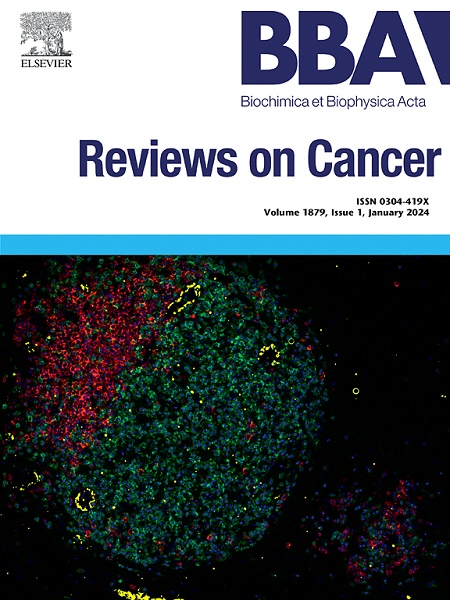脑转移微环境中的髓系细胞。
IF 9.7
1区 医学
Q1 BIOCHEMISTRY & MOLECULAR BIOLOGY
Biochimica et biophysica acta. Reviews on cancer
Pub Date : 2025-04-04
DOI:10.1016/j.bbcan.2025.189311
引用次数: 0
摘要
外周实体瘤的脑转移(BrM)死亡率高,仍然是一个令人望而生畏的临床挑战。除了靶向肿瘤细胞外,研究还关注肿瘤微环境(tumor microenvironment, TME)对BrM治疗的调控。在这里,通过对最近研究的回顾,我们发现骨髓浸润是来自不同原发部位的BrMs的TME的共同特征,尽管大脑被认为是免疫特权部位,并且总是处于免疫抑制状态。肿瘤诱导的骨髓祖细胞,特别是间充质干细胞(MSCs),可能影响髓细胞的脑向性和表型转换。此外,慢性炎症可能是调节免疫抑制性TME和髓细胞重编程的关键因素。本文综述了髓系细胞在TME形成中的作用,以及在BrM前后靶向这些细胞的策略,强调了髓系细胞在BrM治疗中的潜力。然而,神经系统与髓细胞滤过之间的直接关系尚不清楚,值得进一步研究。本文章由计算机程序翻译,如有差异,请以英文原文为准。
Myeloid cells in the microenvironment of brain metastases
Brain metastasis (BrM) from peripheral solid tumors has a high mortality rate and remains a daunting clinical challenge. In addition to the targeting of tumor cells, studies have focused on the regulation of the tumor microenvironment (TME) for BrM treatment. Here, through a review of recent studies, we revealed that myeloid infiltration is a common feature of the TME in BrMs from different primary sites even though the brain is regarded as an immune-privileged site and is always in an immunosuppressive state. Tumor-educated bone marrow progenitors, especially mesenchymal stem cells (MSCs), may impact the brain tropism and and phenotypic switching of myeloid cells. Additionally, chronic inflammation may be key factors regulating the immunosuppressive TME and myeloid cell reprogramming. Here, the role of myeloid cells in the formation of the TME and strategies for targeting these cells before and after BrM are reviewed, emphasizing the potential for the use of myeloid cells in BrM treatment. However, the direct relationship between the neuronal system and myeloid cell filtration is still unclear and worthy of further study.
求助全文
通过发布文献求助,成功后即可免费获取论文全文。
去求助
来源期刊

Biochimica et biophysica acta. Reviews on cancer
医学-生化与分子生物学
CiteScore
17.20
自引率
0.00%
发文量
138
审稿时长
33 days
期刊介绍:
Biochimica et Biophysica Acta (BBA) - Reviews on Cancer encompasses the entirety of cancer biology and biochemistry, emphasizing oncogenes and tumor suppressor genes, growth-related cell cycle control signaling, carcinogenesis mechanisms, cell transformation, immunologic control mechanisms, genetics of human (mammalian) cancer, control of cell proliferation, genetic and molecular control of organismic development, rational anti-tumor drug design. It publishes mini-reviews and full reviews.
 求助内容:
求助内容: 应助结果提醒方式:
应助结果提醒方式:


